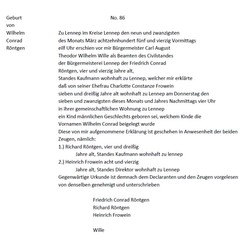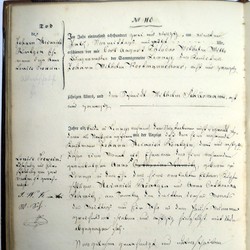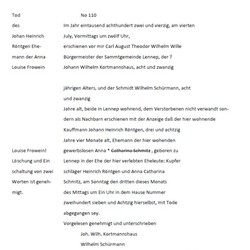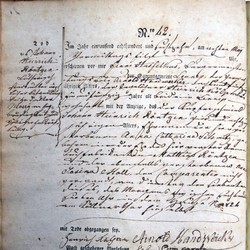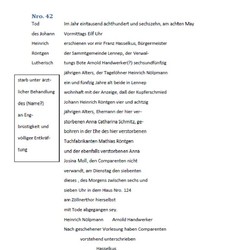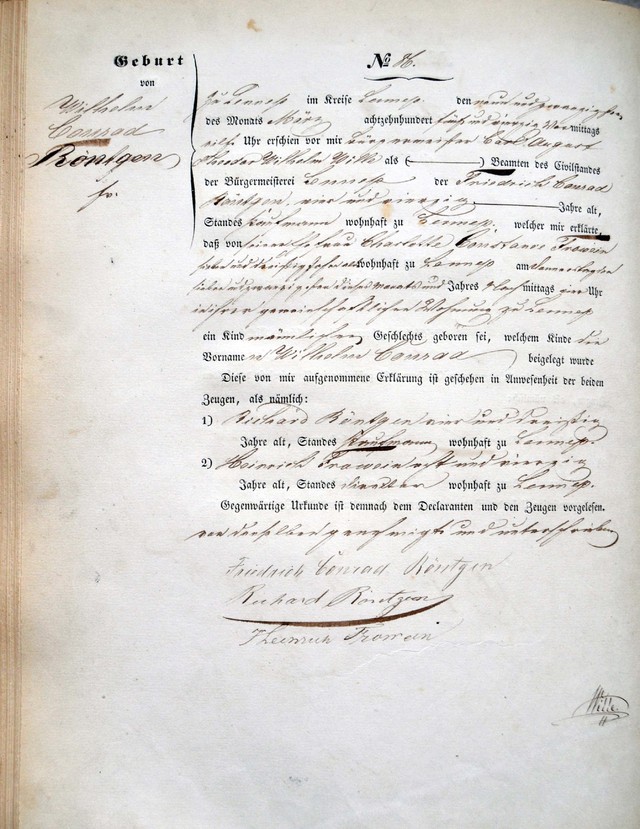 Birth certificate Wilhelm Conrad Röntgen Stadtarchiv Remscheid
Birth certificate Wilhelm Conrad Röntgen Stadtarchiv RemscheidDrapers, parish councils, Latin students - what we know about the Röntgen family
Where does the family of Wilhelm Conrad Röntgen come from? The Foundation for the Birthplace of Wilhelm Conrad Röntgen asked Jörg Holtschneider and his agency Via Temporis to search for the tracks of the Röntgen family.
How far back in time can the roots of the Röntgen family be traced back?
The oldest family member is a person named „Engel“–presumably an abbreviation of Engelbert „Röngen“– at that time without the „t“. Engel was probably born between 1650 and 1660 in Dabringhausen, a little town that today belongs to Wermelskirchen which is South of Remscheid. The biggest problem for local researchers is that the main sources, namely church registers, were often lost to blazes, thievery, or wars. But what we know is that the Röntgen family definitely came to Lennep in 1721. Back then Lennep was an autonomous parish until 1929.
So the family comes from Dabringhausen?
That’s quite sure. According to the still existing church registers these varied names were widely spread in Dabringhausen and the surrounding area.
Thanks to its famous bearer the name Röntgen is known worldwide. What does the name mean?
There are two interpretations: First of all there is–next to the Dabringhausen line–another stirps in the Eifel region, where the vernacular expression “ron” exists which means “twig”. The diminutive suffix “gen” would consequently mean “little twig”. In the figurative sense “ron” also means tall and strong man. “Rönnche(n)” on the other hand would stand for a small and wispy man. Another approach goes back to the Germanic proper names “Runold” or “Runuald”. These names stand for “secret wisdom” which comprises the noted expression for the Germanic character, the rune.
Which professions did the family have?
Wilhelm Conrad Röntgen comes from a sophisticated family. One of his great-grandfather’s brothers emigrated to the Netherlands East Indies (today: Indonesia) and has worked as a secretary for the Dutch East India Company. Moreover, there are surgeons on his mother’s side of the family. The Röntgen family was also dedicated to the church, for example as Lutheran parish councils. In the Latin school of Remscheid, where children of the wealthy families already went before compulsory schooling was introduced, lists referred to the name of Röntgen several times, for example: Johann Mathias Röntgen, the great-great-grandfather of Wilhelm Conrad, who was already mentioned at the beginning of the 18th century.
Consistently, we hear about drapers in the family…
Some members of the Röntgen family were active in the drapery trade and fabrication; the names can be found on a couple of relevant lists. However, it is not easy to clearly confirm these professions. Wilhelm Conrad’s grandfather was listed as a draper/merchant, his father as a manufacturer. From time to time the occupational title “copper maker” appears. The Röntgen family was related by marriage with important draper’s families in Lennep. But we cannot be sure whether they belonged to the town’s wealthy drapers. Since Röntgen’s birthplace home is a rather small house, we can probably conclude that they didn’t because–for example–the house of the Röntgen museum in Lennep is fairly large and it also once belonged to a draper’s family. Thus, it is rather unlikely that the Röntgen family possessed an own factory.
Why did the family later emigrate to Apeldoorn in the Netherlands?
One of the reasons for the emigration is the revolution of 1848/1849 which heavily raged also in the Remscheid-area. Revolutions and riots are always a huge problem for merchants. Furthermore, a large part of the family had died or had emigrated at that point of time. The family of Wilhelm Conrad’s mother already lived in the Netherlands, and the circumstances for trade were much better in that area. The decision to emigrate was probably the right one for the family because in Apeldoorn they lived a well-to-do life; they bought a house there, and the foundation stone of 1850 still exists today.

